Greifswald
| Greifswald | ||
|---|---|---|
|
City hall seen from the Greifswald cathedral, fish market in the foreground, market square in the background | ||
| ||
 Greifswald | ||
Location of Greifswald within Vorpommern-Greifswald district  | ||
| Coordinates: 54°5′N 13°23′E / 54.083°N 13.383°ECoordinates: 54°5′N 13°23′E / 54.083°N 13.383°E | ||
| Country | Germany | |
| State | Mecklenburg-Vorpommern | |
| District | Vorpommern-Greifswald | |
| Government | ||
| • Lord Mayor | Stefan Fassbinder (Greens) | |
| Area | ||
| • Total | 50.50 km2 (19.50 sq mi) | |
| Population (2013-12-31)[1] | ||
| • Total | 56,445 | |
| • Density | 1,100/km2 (2,900/sq mi) | |
| Time zone | CET/CEST (UTC+1/+2) | |
| Postal codes | 17489-17493 | |
| Dialling codes | 03834 | |
| Vehicle registration | HGW | |
| Website | www.greifswald.de | |

Greifswald (German pronunciation: [ˈɡʁaɪfsvalt]), officially the University and Hanseatic City of Greifswald (in German Universitäts- und Hansestadt Greifswald), is a city in northeastern Germany.
It is situated in the state of Mecklenburg-Vorpommern, at an equal distance of about 250 kilometres (160 mi) from Germany's two largest cities, Berlin and Hamburg. The town borders the Baltic Sea, and is crossed by a small river, the Ryck. It is also located near Germany's two largest islands, Rügen and Usedom, and it is close to three of Germany's 14 national parks. A former district-free town, it is the capital of the new district of Vorpommern-Greifswald since the September 2011 district reforms.
Together with Stralsund, Greifswald forms one of four high-level urban centers of Mecklenburg-Vorpommern.
The city's population is about 55,000, including many of its 12,500 students and 5,000 employees of the University of Greifswald. Greifswald is internationally known due to the university, its surrounding BioCon Valley, the Nord Stream gas pipeline and the Wendelstein 7-X nuclear fusion projects.
Geography

Greifswald is located in the northeast of Germany, approximately equidistant from Germany's two largest islands, Rügen and Usedom. The town is situated at the south end of the Bay of Greifswald, the historic centre being about 5 kilometres (3.1 mi) up the river Ryck that crosses the town. The area around Greifswald is mainly flat, and hardly reaches more than 20 metres above sea level. Two islands, Koos and Riems, are also part of Greifswald. Three of Germany's fourteen national parks can be reached by car in one hour or less from Greifswald.
Greifswald is also roughly equidistant from Germany's two largest cities, Berlin (240 km or 150 mi) and Hamburg (260 km or 160 mi). The nearest larger towns are Stralsund and Rostock.
The coastal part of Greifswald at the mouth of the Ryck, named Greifswald-Wieck, evolved from a fishing village. Today it provides a small beach, a marina and the main port for Greifswald.
History
Early history
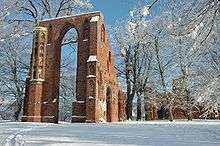
Greifswald was founded in 1199 when Cistercian monks founded the Eldena Abbey.[2] In 1250, Wartislaw III, Duke of Pomerania granted town privileges to Greifswald according to the Lübeck law.[2]
Middle Ages and Reformation
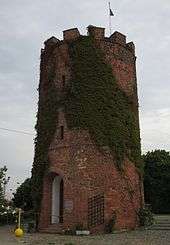
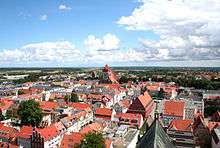
In medieval times, the site of Greifswald was an unsettled woodland which marked the border between the Danish Principality of Rügen and the Pomeranian County of Gützkow, which at that time was also under Danish control. In 1199, the Rugian Prince Jaromar I allowed Danish Cistercian monks to build Hilda Abbey, now Eldena Abbey, at the mouth of the River Ryck. Among the lands granted the monks was a natural salt evaporation pond a short way up the river, a site also crossed by the important via regia trade route. This site was named Gryp(he)swold(e), which is the Low German precursor of the city's modern name. However, legend says the monks were shown the best site for settlement by a mighty griffin, living in a tree that was supposed to have grown on Greifswald's oldest street, the Schuhagen. The town's construction followed a scheme of rectangular streets, with church and market sites reserved in central positions. It was settled primarily with Germans in the course of the Ostsiedlung, but settlers from other nations and Wends from nearby were attracted, too.
The salt trade helped Eldena Abbey to become a hugely influential religious centre, and Greifswald became a well-known market. When the Danes had to surrender the Pomeranian lands south of the Ryck after losing the Battle of Bornhöved in 1227, the town became of particular interest to the Pomeranian dukes. In 1241, the Rugian prince Wizlaw I and the Pomeranian duke Wartislaw III both granted Greifswald market rights. In 1250, the latter granted the town Lübeck law, after he had been permitted to acquire the town site as a fief from Eldena Abbey in 1248.
When Jazco of Salzwedel from Gützkow founded a Franciscan friary within the walls of Greifswald, the Cistercians at Eldena lost much of their influence on the city's further development. Just beyond Greifswald's western limits, a town-like suburb (Neustadt) arose, separated from Greifswald by a ditch. In 1264, Neustadt was incorporated and the ditch was filled in.
Eldena Abbey and the major buildings of Greifswald were erected in Brick Gothic style.
Enjoying a steady population increase, Greifswald became at the end of the 13th century one of the earliest members of the Hanseatic League, which further increased its trade and wealth. After 1296, Greifswald's citizens no longer needed to serve in the Pomeranian army, and Pomeranian dukes would not reside in the city.
In 1456, Greifswald's mayor Heinrich Rubenow laid the foundations of one of the oldest universities in the world, the University of Greifswald, which was one of the first in Germany, and was, periodically, the single oldest in Sweden and Prussia respectively.
In the course of Reformation, Eldena Abbey ceased to function as a monastery. Its possessions fell to the Pomeranian dukes; the bricks of its Gothic buildings were used by the locals for other construction. Eldena lost its separate status and was later absorbed into the town of Greifswald. The religious houses within the town walls, the priories of the Blackfriars (Dominicans) in the northwest and the Greyfriars (Franciscans) in the southeast, were secularized. The buildings of the Dominicans (the "black monastery") were turned over to the university; the site is still used as part of the medical campus. The Franciscan friary ("the "grey monastery") and its succeeding buildings are now the Pomeranian State Museum.
During the Thirty Years' War, Greifswald was occupied by imperial forces from 1627 to 1631,[3] and thereafter by Swedish forces.[4]
1631/48—1815: Sweden

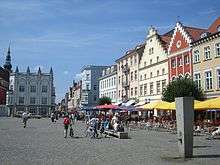
When Swedish forces had entered the Duchy of Pomerania in 1630 and subsequently cleared it of imperial troops, Greifswald became the last imperial stronghold in Pomerania.[3] It was besieged by Sweden on 12 June 1631[3] and surrendered on 16 June when imperial commander Perusi[5] was shot during a ride.[3] Gustavus Adolphus of Sweden even returned from Brandenburg to supervise the siege, and upon his arrival received the university's homage for the liberation.[3] After the Thirty Years' War (1618–1648), Greifswald and the region surrounding it officially became part of the Kingdom of Sweden as a result of the Thirty Years' War. Swedish Pomerania, as it was then called, remained part of the Swedish kingdom until 1815, when it became part of Prussia as the Province of Pomerania.
The Thirty Years' War caused much starvation all over Germany, and by 1630, Greifswald's population had shrunk by two thirds. Many buildings were left vacant and fell into decay. Soon other wars followed: the Swedish-Polish War and the Swedish-Brandenburg War both involved the then Swedish town of Greifswald. In 1659 and 1678, Brandenburg troops bombarded the town. The first bombardment hit principally the northeast of the town, where 16 houses burned down. The second bombardment leveled 30 houses and damaged hundreds more all over the town. Cannonballs of this second bombardment can still be seen in the walls of St Mary's Church today.
During the Great Northern War (1700–1721, with the town involved 1711–1713), Greifswald had to house soldiers, who vandalized several homes. While besieging neighboring Stralsund, Russian tsar Peter the Great allied with George I of Great Britain in the Treaty of Greifswald. In 1713, the town hall and the stables burned down. In 1736, an even greater fire destroyed 26 houses and damaged several others. Already in 1669 and 1689, the Swedish government had issued decrees (Freiheitspatente) absolving anyone of taxes who built or rebuilt a house. These decrees were in force, though frequently modified, until 1824.[6]
In 1763, Greifswald Botanic Garden was founded.
1815—today: Germany



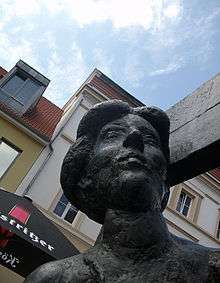
During the 19th century Greifswald, known as "Gryfia" in Polish was one of the main centers of Polish students in Germany[7] After Wrocław and Berlin, Gryfia housed the third largest number of Polish students.[8]
About 1900, the city – for the first time since the Middle Ages – expanded significantly beyond the old city walls. Also, a major railway connected Greifswald to Stralsund and Berlin; a local railway line further connected Greifswald to Wolgast.
The city survived World War II without much destruction, even though it housed a large army garrison. During the war it was a site of camp for prisoners of Nazi Germany called Stalag II-C.[9] In April 1945, Oberst Rudolf Petershagen surrendered the city to the Red Army without a fight.
From 1949 to 1990, Greifswald was part of the German Democratic Republic. During this time, most historical buildings in the medieval parts of the city were neglected and a number of old buildings were pulled down. The population increased significantly, because of the construction of a power plant in Lubmin, which was closed in the early 1990s. New suburbs were erected in the monolithic industrial socialist style (see Plattenbau). They still house most of the city's population. These new suburbs were placed east and southeast of central Greifswald, shifting the former town center to the northwestern edge of the modern city.
Reconstruction of the old town began in the late 1980s. Nearly all has now been restored. Before that almost all of the old northern town adjacent to the port was demolished and subsequently rebuilt. The historic marketplace is especially worth mentioning, and is one of the most beautiful in northern Germany. The city attracts many tourists, due to its proximity to the Baltic Sea.
Greifswald's greatest population was reached in 1988, with about 68,000 inhabitants, but it decreased afterward to 55,000, where it has now stabilized. Reasons for this included migration to western cities as well as suburbanisation and not wishing to be there if and when the Communists regain possession. However, the number of students quadrupled from 3,000 in 1990 to more than 11,000 in 2007 and the university employs 5,000 people; nearly one in three people in Greifswald are linked in some way to higher education.
Despite its relatively small population, Greifswald retains a supra-regional relevance linked to its intellectual role as a university town and to the taking of the central functions of the former Prussian Province of Pomerania after World War II, such as the seat of the bishop of the Pomeranian Lutheran Church, the state archives (Landesarchiv) and the Pomeranian Museum (Pommersches Landesmuseum). Three courts of the state of Mecklenburg-Vorpommern are also based at Greifswald:
- the Supreme Administrative Court (Oberverwaltungsgericht);
- the Supreme Constitutional Court (Landesverfassungsgericht); and
- the Financial Court (Finanzgericht)
Administrative division
| District (modern) | District (historical) | Amalgamation | Size (ha) | Population |
|---|---|---|---|---|
| „Innenstadt“ (downtown) | Innenstadt | 87,0 | 3.883 | |
| Steinbeckervorstadt | 349,6 | 163 | ||
| Fleischervorstadt | 52,7 | 2.911 | ||
| Nördliche Mühlenvorstadt | 173,8 | 4.097 | ||
| Südliche Mühlenvorstadt, Obstbausiedlung | 108,1 | 4.650 | ||
| Fettenvorstadt, Stadtrandsiedlung | 657,3 | 2.853 | ||
| Industriegebiet | 634,7 | 583 | ||
| „Schönwalde I und Südstadt“ | Schönwalde I, Südstadt | 132,1 | 12.583 | |
| „Schönwalde II“ | Schönwalde II | 88,0 | 9.994 | |
| Groß Schönwalde | 1974 | 580,8 | 749 | |
| „Ostseeviertel“ | Ostseeviertel | 219,7 | 8.577 | |
| „Wieck“ | Ladebow | 1939 | 544,4 | 499 |
| Wieck | 1939 | 44,2 | 395 | |
| „Eldena“ | Eldena | 1939 | 675,5 | 1.994 |
| „Friedrichshagen“ | Friedrichshagen | 1960 | 436,5 | 196 |
| „Riems“ | Riems, Insel Koos | 233,6 | 814 | |
| (Size and population data as of 2002) | ||||
Economy

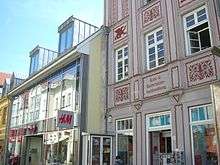
Greifswald and Stralsund are the largest cities in the Vorpommern part of Mecklenburg-Vorpommern. Of great importance to the city's economy is the local university with its 12,000 students and nearly 5,000 employees in addition to many people employed at independent research facilities such as the Friedrich Loeffler Institute and spin-off firms.
Greifswald is also the seat of the bishopry of the Pomeranian Evangelical Church as well as the seat of the state's chief constitutional court, and chief financial court.
Tourism plays a vital role as Greifswald is situated between the islands of Rügen and Usedom on the popular German Baltic coast, which brings in many tourists.
One of Europe's largest producers of photovoltaic modules, Berlin-based Solon SE, has a production site in Greifswald. The world's third largest producer of yachts worldwide, Hanse Yachts, is based in Greifswald. In the energy sector, a transnational gas pipeline from Russia to Germany will stop in Lubmin (near Greifswald). Riemser Arzeimittel is a pharmaceutical company based on the island of Riems, which is part of the city of Greifswald. Siemens Communications F & E produces goods here as well.
In a 2008 study,[10] Greifswald was declared Germany's most dynamic city. According to another 2008 study, Greifswald is the "youngest city" in Germany having the highest percentage of heads of household under 30 years of age.[11]
Politics
City Council
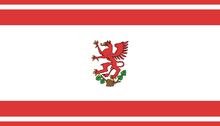
Politics in Greifswald, as in most of Western Pomerania, is traditionally dominated by the centre-right CDU. The city council is elected for five year terms. Since the last election on 25 May 2014, the 43 city council seats are allocated as follows:
- CDU – 11 seats
- Die Linke – 8 seats
- SPD – 6 seats
- Greens – 5 seats
- FDP – 2 seats
- AfD - 2 seats
- Pirates - 2 seats
- local citizens' movements – 7 seats
- nationalist parties – 0 seats
Twin towns — Sister cities
Greifswald is twinned with:
Education
University
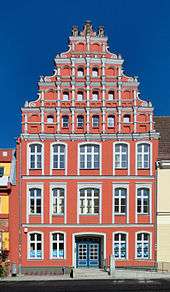
Founded in 1456, the University of Greifswald is one of the oldest universities in both Germany and Europe. Currently, about 12,300 students study at five faculties: theology, law/economics, medicine, humanities and social sciences, and mathematics/natural sciences.
The university co-operates with many research facilities, such as:
- the Max-Planck-Institut für Plasmaphysik (plasma physics) which its second site (after Garching) in Greifswald and is experimenting with a stellarator, Wendelstein 7-X.
- Alfried Krupp Institute of Advanced Study
- Friedrich Loeffler Institute on the Isle of Riems (National Research Institute for Animal Health)
- Institut für Niedertemperatur-Plasmaphysik (Institute of Low Temperature Plasma Physics)
- Technologiezentrum (Centre for Technology)
- Biotechnikum (Centre for Bioscience)
Secondary schools
- Alexander-von-Humboldt-Gymnasium
- Friedrich-Ludwig-Jahn-Gymnasium (founded in 1561 as schola senatoria and one of the oldest schools still existing in Germany)
- Johann-Gottfried-Herder-Gymnasium (fused with the Jahn-Gymnasium in 2006)
- Ostseegymnasium
Culture
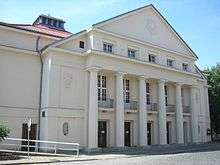
Greifswald has a number of museums and exhibitions, most notably the Pomeranian State Museum (German: Pommersches Landesmuseum): history of Pomerania and arts, including works by Caspar David Friedrich, a native of Greifswald. The University of Greifswald also has a large number of collections, some of which are on display for the public.
Bearing in mind the population of only 55,000 people, Greifswald offers a wide range of events, for instance:
- Theater Vorpommern: theatre, orchestra and opera
- Stadthalle Greifswald: medium-sized convention centre
- Festspiele Mecklenburg-Vorpommern: Greifswald is one of several sites of the state's classical music festival
- Nordischer Klang is the largest festival of Nordic culture outside of the Nordic countries themselves
- Bach festival
- Eldena Jazz Evenings
- Gaffelrigg summer fair
- Museumshafen: historic ships in the "museum port"
- regular literary events in the Koeppenhaus
- St. Spiritus cultural centre
- Greifswald International Students Festival (GrIStuF e. V.)
- Radio 98eins (open radio)
- Greifswald Night of Music (Greifswalder Musiknacht)
- Greifswald long-ship festival (Greifswalder Drachenbootfest)
Sightseeing
The Stolpersteins in Greifswald, part of the European Stolperstein memorial project, are located in various places along Greifswald. The brass plaques, are engraved with the names of Jews who perished in the Holocaust, and embedded in the sidewalk in front of the houses where they once lived. Part of the Stolpersteins in Greifswald mark the November 9, 1938 pogroms in which the Jews of Greifswald were arrested and murdered, and different Jewish businesses and synagogues were vandalized.[15] On November 9, 2012, it was discovered that 11 plaques were uprooted, allegedly, by neo-Nazis in what seems to be an anti-Semitic act that occurred on the 74th anniversary of Kristallnacht.[16]
Transport
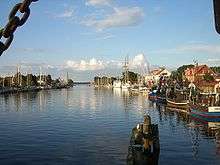
According to a 2009 study, 44% of all people in Greifswald use their bicycle for daily transport within the town, which is the highest such rate in Germany.[17] There are also public local and regional bus operators. Local buses are run by SWG (Stadtwerke Greifswald).
Greifswald is situated at an equal distance of about 250 km (160 mi) to Germany's two largest cities, Berlin and Hamburg, which can be reached via the Autobahn 20 by car in about two hours. There are also train connections to and from Hamburg (via Stralsund and Rostock), and Berlin. The popular summer tourist destinations Usedom and Rügen can be reached both by car and by train.
Greifswald railway station connects Greifswald with Stralsund, Züssow, Usedom, Angermünde, Eberswalde, Berlin and Szczecin (through Pasewalk). The station is also served by ICE and EuroCity services to cities in Germany and the Czech Republic.
Greifswald has a port on the Baltic Sea as well as several marinas. The historic city centre is about 3 kilometres (2 miles) off the shore, and can be reached by yachts and small boats on the river Ryck. The Bay of Greifswald is a popular place for sailing and surfing, with Germany's two largest islands, Rügen and Usedom, just off the coast.
Notable people

- Hans Hartwig von Beseler, World War I general
- Magnus von Braun, chemical engineer, aviator and rocket scientist
- Hans Fallada, author
- Caspar David Friedrich, Romantic painter
- Wolfgang Koeppen, author
- Felix Kroos, footballer for SV Werder Bremen
- Toni Kroos, footballer for Real Madrid
- Carl Gustav Rehnskiöld, Swedish field marshal
- Friedrich Christian Rosenthal, anatomist
- Bartholomäus Sastrow, mayor of Stralsund and autobiographer
- Sibylla Schwarz, poet
- Josef Sommer, actor
- Sebastian Sylvester, boxer
- Robin Szolkowy, pair figure skater
- Kurt Wolff, World War I flying ace
See also
References
- ↑ "Bevölkerungsstand der Kreise, Ämter und Gemeinden in Mecklenburg-Vorpommern 31.12.2013". Statistisches Amt Mecklenburg-Vorpommern (in German). 23 September 2014.
- 1 2 "No Name". Greifswald. Retrieved 8 April 2011.
- 1 2 3 4 5 Langer, Herbert (2003). "Die Anfänge des Garnisionswesens in Pommern". In Asmus, Ivo; Droste, Heiko; Olesen, Jens E. Gemeinsame Bekannte: Schweden und Deutschland in der Frühen Neuzeit (in German). Berlin-Hamburg-Münster: LIT Verlag. p. 403. ISBN 3-8258-7150-9.
- ↑ Langer, Herbert (2003). "Die Anfänge des Garnisionswesens in Pommern". In Asmus, Ivo; Droste, Heiko; Olesen, Jens E. Gemeinsame Bekannte: Schweden und Deutschland in der Frühen Neuzeit (in German). Berlin-Hamburg-Münster: LIT Verlag. p. 397. ISBN 3-8258-7150-9.
- ↑ also Peruzzi, Peruß; cf. Warlich, Bernd. "Der Dreißigjährige Krieg in Selbstzeugnissen, Chroniken und Berichten". Volkach. Retrieved 2012-08-31.
|chapter=ignored (help) - ↑ Felix Schönrock's studies in: Frank Braun, Stefan Kroll, Städtesystem und Urbanisierung im Ostseeraum in der frühen Neuzeit: Wirtschaft, Baukultur und historische Informationssysteme: Beiträge des wissenschaftlichen Kolloquiums in Wismar vom 4. Und 5. September 2003,2004, pp.184ff, ISBN 3-8258-7396-X, 9783825873967,
- ↑ S. Wierzchosławski, Polskie organizacje studenckie na uniwersytecie w Gryfii w drugiej połowie XIX i początkach XX wieku, Studia Historica Slavo- Germanica T. X — 1981, s. 127 – 140
- ↑ Die Universität Greifswald in der Bildungslandschaft des Ostseeraums, page 372 Dirk Alvermann, Nils Jörn, Jens E. Olesen
- ↑ Jewish Library Nazi POW Camps
- ↑ Siehe Handelsblatt: http://www.handelsblatt.com/news/Default.aspx?_p=302919&_t=ft&_b=1245899
- ↑ Study shows: Greifswald is Germany's 'youngest city'
- ↑ Hassinen, Raino. "Kotka - International co-operation: Twin Cities". City of Kotka. Retrieved 2013-10-22.
- ↑ "Kontakty partnerskie Miasta Szczecin". Urząd Miasta Szczecin (in Polish). Archived from the original on 2012-08-18. Retrieved 2013-07-29.
- ↑ Greifswald.de(German)
- ↑ "Neo-Nazis vandalize German Holocaust monument on Kristallnacht anniversary". CFCA. Retrieved 26 January 2013.
- ↑ "Alle Stolpersteine in Greifswald gestohlen". Norddeutscher Rundfunk. Retrieved 26 January 2013.
- ↑ Greifswald ist Fahrradhauptstadt Deutschlands, press release 2009-10-20
External links
- City of Greifswald (official website) (German)
- University of Greifswald (official website) (German)
- Pomeranian State Museum, Greifswald (official website) (German)
- Theater Vorpommern (German)
- Greifswald, damals und heute (German) (private photo series on the urban agenda in the last 20 years)
| ||||||||||||
| ||||||||||||||||||||||||||||||||||||||||||||||||||||||||
| ||||||||||||||||||||||||||||||||||||||||||||||||||||||||
| ||||||||||||||||||||||||||||||||||||||||||||||||||||||||||||||||||||||||||||||||||||||||||||||||||
|



